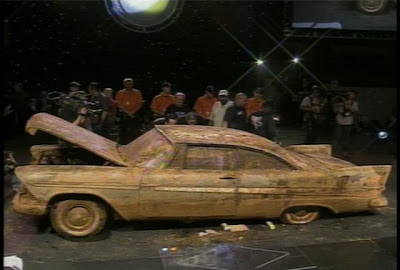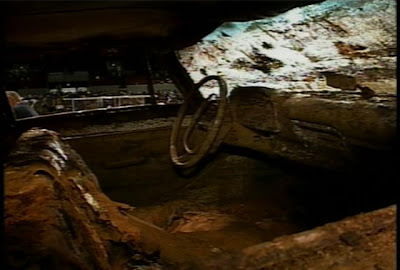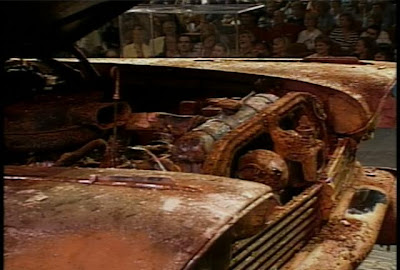Three Audi R10 TDI cars in the 24 Hours of Le Mans Comeback of Le Mans record winner Tom Kristensen Six veterans and three youngsters compete for Audi On 16/17 June 2007 AUDI AG will again tackle one of motorsport’s biggest challenges of …
Month: June 2007
The World’s First Solar Cell Phone

We’ve seen the prototypes and heard the speculation for years now, but here we have it, the world’s first solar cell phone, and you can buy one right now…if you happen to live in China.
HiTech Wealth telecommunications has just begun selling the S116 and the specs are pretty impressive. However, the $510 pricetag will have you wondering why you don’t just get an iPhone. A 1.3 mpx camera, and an MP3 player are fairly standard additions to cell phones these days, but the solar panels do make this guy stand out.
The panels trickle-charge the battery in any amount of light, including indoors (or even by candlelight), and the battery life is 2.5 times longer than it would without the panels. An hour of direct sunlight will give users 40 extra minutes of talk time.
While this first model is pretty exciting, HiTech Wealth will be releasing six more solar phones within the year and has promised 30 solar models before 2009.
Via Inhabitat and Xinhua News
TiTech’s Magic Recycling Sorting Machine

Oh my lord do I hate sorting recycling. But I’m a good citizen, and I understand the benefits, so I do it. Sticky fingers and precious time are a price I must pay. But soon we won’t ever have to do it again.
Air jets and cameras and magnets…oh my! New systems for automatically sorting recycling are completely removing the need for pre-sorting, and thus dramatically improving recycling rates and efficiency across the world. While magnets have been in place to sort tin for ages, TiTech’s Near InfraRed sensor sorts recyclables basically by looking at them.
The technology is able to determine the "type, shape, color and position" of the items. Then, air jets positioned after the camera then launch the item onto a different conveyor system. The system works with 98% accuracy and can process up to 10 tons per hour. Currently 1,000 of these are active in 16 countries around the world.
Eliminating the amount of people needed to run a recycling plant will help to lower the cost and make it competitive to new materials. This is great for people that already buy recyclables, and only encourages those that don’t to make the change.
via Treehugger and the Economist
Visualizing World Polution

When the air is polluted you can see it, smell it, even feel it. But polluted water isn’t so obvious (until rivers start catching fire.) Soo-in Yang and David Benjamin, creators of the River Glow Project, understand that people need these feedbacks. Their solution is a combination of pods containing red and green LEDs and a simple pH sensor. The LEDs light up red if poor water quality is detected and green if it is good.
The project would allow people to see from a distance if the water is good or bad at a cost of less than $1000 per unit.
When things look fine on the surface, it is easy to ignore, but if pollution like this can be visualized, people will certainly pay more attention. I can’t help but think of the statue of Vulcan, the Roman god, who presides over my hometown of Birmingham Alabama. For some forty years, his torch turned shone red on days when there were traffic fatalities. Visualization is a powerful tool, and when it can be mixed with public art, all the better.
Inhabitat
Via Engadget
Time Takes Its Toll: Tulsa’s ’57 Plymouth Belvedere Covered In Rust
 As many feared on Wednesday when workers discovered that the 1957 Plymouth Belvedere’s crypt was partially filled with water, the past 50 years had not been the kindest to Tulsa’s buried car. On Friday night (June 15), half a century after Tulsa residents closed the lid on the two-door coupe, the ceremonial curtain went up and the protective plastic wrapping removed only to reveal the ’57 Belvedere completely covered in rust.
As many feared on Wednesday when workers discovered that the 1957 Plymouth Belvedere’s crypt was partially filled with water, the past 50 years had not been the kindest to Tulsa’s buried car. On Friday night (June 15), half a century after Tulsa residents closed the lid on the two-door coupe, the ceremonial curtain went up and the protective plastic wrapping removed only to reveal the ’57 Belvedere completely covered in rust.
Definitely not a happy site for any petrolhead. But you know something, this old gal is so special that all the rust in the world couldn’t take her dignity away. 50 years buried under the earth, people came, people left, the man went to the moon and back and Plymouth disappeared, but she was there, waiting patiently for her time to come to see the sun again. Maybe not the way she dreamt it to be, but heck, who can say that we are what we used to be. -More pictures and a video of the unearthing after the jump
Via: Le blog auto , Picture Source: kotv
Volkswagen launch Touareg Adventure to promote new SUV
Volkswagen of America has come up with a three-day off road driving course in Moab, UT, called Touareg Adventure, to introduce the Touareg 2 SUV that will be released later this month.
Volkswagen brand communications director, Steve Keyes, said Volkswagen will target current owners and prospects through a variety of promotions which includes dealership run initiatives. According to Keyes, the first couple of sessions are sold out. “It will run through the end of October at which time we’ll evaluate it. If we’re happy with the results we will extend it into year two, which is our inclination at this point anyway,” said Keyes.
Keyes also said that most SUV buyers rarely use the off-road features built in to the vehicles, that is why differentiating one feature from another can be a challenge. This tour is actually set to help consumers make the distinction between Touareg and its competitors by showcasing its off-road capabilities and technologies, according to the Auburn Hills, MI-based automaker.
“When people are driving SUVs to and from work and the supermarket there’s not a lot to differentiate,” Keyes said. “So we felt the best way to leverage our capabilities was to offer this experience.”
Volkswagen will also be using consumer generated media created on site to help promote Touareg Adventure and the new SUV. Participants will be able to write blogs and post photos of their experiences from the Touareg Room at the housing lodge. “We’ve learned a big part of the success of these types of programs is from word-of-mouth,” Keyes said.
Before letting consumers take part, Volkswagen first invited the media out to Moab for the program’s initial run. Keyes said 15 media representatives were able to join the trip.
According to Keyes, most of the media representative that came to the initial run were from web-based and weekly automotive magazines. But there were also some from the lifestyle media “We’re trying to focus on the web-based and weekly publications because they can get the story out quicker,” said Keyes. He mentioned that among the media personnel who participated were from VWvortex.com, Edmunds.com, Autoafficianado.com and other “general automotive Web sites,
Consumer participants receive a two-and-a-half-hour orientation on off-road technique the first day, and spend the following two days behind the wheel. Keyes said unlike other off-road courses, Volkswagen wanted the participants to operate the SUVs themselves.
“Some programs last one day, they put you on a dirt road and give the participant very little actual drive time,” Keyes mentioned. “Here, you’re driving the whole time. There’s an instructor in every car, but they’re in the passenger seat. And by the end of the first day they will have gone through some of the more challenging areas of Moab… [giving] them a sense of accomplishment.”
Interested consumers can sign up at Touaregadventure.com. The price per person is $2,000, which gets them an advance welcome kit, resort lodging that offers single occupancy and meals.
EcoJet and Airbus to Cut Airline Carbon by Half

British low cost carrier easyJet
has unveiled a new aircraft design dubbed the "ecoJet" as part of a
comprehensive plan to cut air-travel related carbon emissions in half
by 2015. CEO of easyJet Andy Harrison reports that Boeing and Airbus
are both interested in producing it.
"This is not Star Trek. This is the future," Harrison said. "If it were to be made available today, we would order hundreds of them for fleett replacement. We are currently spending 4 billion pounds (USD $7.88 billion) on aircraft — they are listening to us."
Similar in design to the ultra-efficient Piaggio Avanti and the Boeing "Fozzie",
the rear-mount "push style" placement of the engines improves the
efficiency of the wings by removing them from the engine’s wake. A
combination of lightweight materials, smaller and more aerodynamic
designs, and fuel sipping external rotor engines – capable of today’s
outputs but consuming 25% less fuel – all add up to savings of about
40%. Additional efficiencies are expected to come from "air traffic
control improvements". This comes on the same day Airbus announced green targets for a 50% reduction in CO2 emissions for their aircraft and a 30% decrease in company-wide energy consumption by 2020.
via MSNBC and Airwise News
Oil Tycoon Planning World’s Largest Windfarm

T. Boone Pickens wants to build the largest wind farm in the world. You might assume that with a name like T. Boone Pickens, this guy would be some kind of oil tycoon. Funny thing is, you’d totally be right.
You know wind power has made it big when Texas oil moguls start getting into the business. And, of course, everything is bigger in Texas.
Pickens’ wind project will stretch over 200,000 acres in four Texas panhandle counties and produce over 4000 megawatts of power…enough to power around one million homes.
Of course, these plans don’t always become reality, but the prospect of a four gigawatt $6 billion solar plant is pretty freakin’ exciting. If approved, the plant would begin construction in 2010. And that may be the first time in my life saying "Thanks" to an oil tycoon.
Via BusinessWeek
Waves Could Power the World 2X Over

Ever sit by the ocean, and watch a buoy or a seagull bob up and down without end? The energy it
takes to move all that water up and down is massive. Prevailing winds,
temperature differentials, strong weather and even the rotation of the
Earth all contribute to the never-ending crash of waves against the
shore, and viewed from a certain perspective, that’s a lot of energy
going to waste:
The World Energy
Council has estimated that approximately 2 terawatts (2 million
megawatts), about double current world electricity production, could be
produced from the oceans via wave power. It is estimated that 1 million
gigawatt hours of wave energy hits Australian
shores annually and that 25% of the UKÂ’s current power usage could be
supplied by harvesting its wave resource.
The image above shows average yearly wave-power energy in various parts of the world in kilowatts per METER!
The
same ocean currents that fueled the economic growth of the 18th and
19th centuries may now help power the countries that prospered as a
result – with the best sites in the world lying off the shores of
developed countries, look for this alternative energy to (I can’t help
myself) make some waves in the coming years. Scotland, Portugal,
Australia and Hawaii already have installations underway or in place,
and feasibility studies are being undertaken by Spain, Norway, USA and
New Zealand.
via Ceto.com
Mazda’s Simple Engine Mod Burns 20% Less Gas

Mazda’s new Miller-cycle engine will power the new Mazda2, (named the Demio for the US).
Mazda Motor Corporation has developed a new, naturally
aspirated 1.3-liter Miller-cycle gasoline engine, which will power the all-new Mazda2
when it goes on sale in Japan
in July 2007. The Miller-cycle engine
usually depends on having a really big super charger but Mazda has figured out
a way to use the Miller-cycle on a normally aspirated engine.
The Miller-cycle is a fancy name for a simple change in the
valve timing for an engine. It allows
the compression stroke of a 4-cycle engine to begin later than typical. Less power wasted on compression means more
efficiency.
In combination with MazdaÂ’s first continuously variable
transmission (CVT), the engine enables the new Mazda2 to offer 54 mpg US, an
improvement of approximately 20% compared with MazdaÂ’s current 1.3-liter
engine model.
In addition to the new powertrain, the all-new Mazda2 has
been made approximately 220 lb lighter than its predecessor through a strict weight
reduction program, which results in quick handling to go along with the
significantly improved fuel economy.
I
can see no reason that the Miller-cycle engine can’t be used to improve
the efficiency of larger engines and/or engines in hybrids. I wonder
what the carbon footprint of a Miller-cycle hybrid car running on
cellulosic ethanol would be?
66 Bottles of Beer on the Roof
 |
Once while traveling through the southern US I saw a DIY solar hot
water heater made from an old Chevy, that was up on blocks, painted
black and the proud owner had run 200 feet of garden hose through the
interior. It provided enough heat for his family to shower he said.
From
the "Weird Asia News" blog we get the story of a man who made his
family a solar hot water heater from 66 recycled beer bottles. He
should have called, I could have helped him empty the bottles.
Weird Asia News:
A Chinese farmer has made his own solar-powered water heater out of beer bottles and hose pipes.
“I invented this for my mother. I wanted her to shower comfortably,” says Ma Yanjun, of Qiqiao village, Shaanxi province.
MaÂ’s invention features 66 beer bottles attached to a board. The
bottles are connected to each other so that water flows through them.Sunlight heats the water as is passes slowly through the bottles
before flowing into the bathroom as hot water, reports China Economy
Network.Ma says it provides enough hot water for all three members of his family to have a shower every day.
And more than 10 families in the village have already followed suit and installed their own versions of MaÂ’s invention.
Via: BoingBoing, Wierd Asia News
Building a Better Brick

Henry Liu, a retired civil engineer, has won the Popular Science 2007 Invention Award for producing a replacement for the more than 9 billion clay bricks manufactured in the US each year. Manufactured from fly ash,
a byproduct of coal combustion with a worldwide surplus production
running in the hundreds of millions of tons each year, these new bricks
are as strong and safe as the bricks we’re all used to seeing, cost 20%
less to make, and are far more environmentally friendly.
Old
‘n’ Busted: clay bricks are fired in a kiln at over 2000°F (1100°C).
New Hotness: Liu’s new building material is cured in a 150°F (66°C)
steam bath after exiting a 4000 psi (28,000 kPa) press, saving massive
amounts of energy and reducing the carbon footprint for builders
considerably. In addition, the new bricks are easier to use which will
save bricklayers time, and homebuilders money. To top it all off, the
bricks may also improve air quality.
Having recently passed federal safety standards in the US, Liu will begin licensing his technology to manufacturers in 2008.
via PopSci.com


